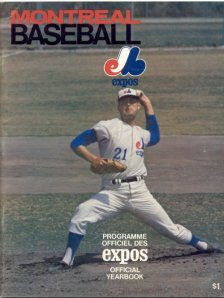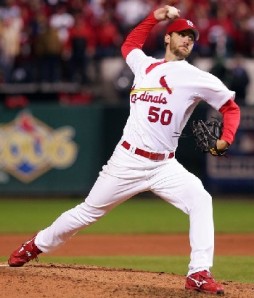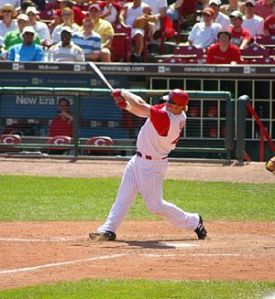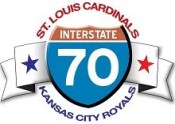In my last entry, I issued something of a cease-and-desist order on criticizing the Cardinals front office over the Albert Pujols contract negotiations. This time, we’ll take a slightly different approach and try to put into perspective how privileged we are to see the big man playing first base in St. Louis.
Bill White (1957-1965). 24 WAR (20 offensive, 4 defensive)
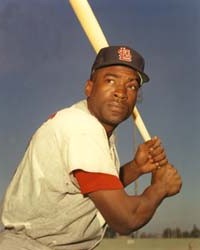 There is no denying that Bill White could hit the ball. Oh, could he ever hit the baseball. The 4 dWAR for his time in St. Louis is a bit surprising because his defense seemed to be much better than that, as suggested by his seven consecutive gold gloves. The big man (for his era) was as graceful as a predatory cat, and his ability to track down a pop up over his head was as good as anybody. I could recall some of my dad’s stories about watching him play, but instead I’ll reiterate: seven consecutive Gold Gloves between 1960 and 1966.
There is no denying that Bill White could hit the ball. Oh, could he ever hit the baseball. The 4 dWAR for his time in St. Louis is a bit surprising because his defense seemed to be much better than that, as suggested by his seven consecutive gold gloves. The big man (for his era) was as graceful as a predatory cat, and his ability to track down a pop up over his head was as good as anybody. I could recall some of my dad’s stories about watching him play, but instead I’ll reiterate: seven consecutive Gold Gloves between 1960 and 1966.
Ken Boyer may have won the National League Most Valuable Player award in 1964, but White’s second half turnaround was a big part of the Cardinals catching the Phillies in September.
George Crowe (1959-1961) .5 WAR (.5 offensive, 0 defensive)
Crowe had been an amazing athlete, playing both baseball and basketball before finally settling on hitting the ball instead of bouncing it. He was a veteran of the Negro Leagues and one of the first wave of players to accompany Jackie Robinson in tearing down the color barrier in baseball. The big man was at the end of his playing career when he came to St. Louis and was used primarily as a pinch hitter and backup starter when Bill White needed a day off, which wasn’t often. Even at age 38, he managed to hit .301 in just over 100 at-bats – which included 8 home runs. Yes, the man could hit the baseball. Crowe’s biggest contribution to the Cardinals was as a role model for a some of the young players who were battling the early days of baseball’s integration efforts. Bob Gibson recounts in 60ft 6in how Crowe helped him and teammate Curt Flood deal with some unfair events early in their career, and how to overcome them. While he may be long forgotten as a player off the bench, his influences can be seen in the development and determination of Gibson and Flood.
Orlando Cepeda (1966-1968) 11 WAR (10 offensive, 1 defensive)
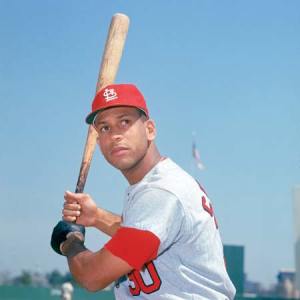 Like Bill White, Cepeda developed as a first baseman. Unfortunately the Giants also had a youngster by the name of McCovey in their minor league system, which meant that Cepeda had to move to the outfield if he wanted to stay on the roster. The wear and tear on his legs took a big toll, and the subsequent drop off in production allowed the 1966 Cardinals to swing a sweatheart of a deal, sending Ray Sadecki westward for Cha Cha Cha. In St. Louis, he returned to his more comfortable position and the production came back with a vengeance. Thanks to a freak injury to Bob Gibson in July 1967, Cepeda became the obvious choice as NL MVP, turning in almost Albert Pujols type offensive numbers. A big drop off in production in 1968, probably due to an injury suffered late in the 1967 season, prompted his relocation to Atlanta and another return to All Star form. He was a steady first baseman with soft hands, but when your infield consists of Julian Javier and Dal Maxvill, nearly anybody could play first base.
Like Bill White, Cepeda developed as a first baseman. Unfortunately the Giants also had a youngster by the name of McCovey in their minor league system, which meant that Cepeda had to move to the outfield if he wanted to stay on the roster. The wear and tear on his legs took a big toll, and the subsequent drop off in production allowed the 1966 Cardinals to swing a sweatheart of a deal, sending Ray Sadecki westward for Cha Cha Cha. In St. Louis, he returned to his more comfortable position and the production came back with a vengeance. Thanks to a freak injury to Bob Gibson in July 1967, Cepeda became the obvious choice as NL MVP, turning in almost Albert Pujols type offensive numbers. A big drop off in production in 1968, probably due to an injury suffered late in the 1967 season, prompted his relocation to Atlanta and another return to All Star form. He was a steady first baseman with soft hands, but when your infield consists of Julian Javier and Dal Maxvill, nearly anybody could play first base.
Joe Torre (1969, 1971-1973) – not gonna list his WAR breakout, just not gonna do it
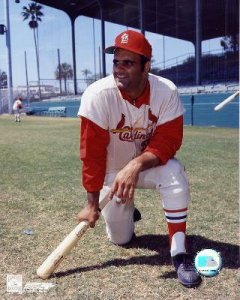 Joe Torre was one of the best pure hitters in Cardinals history, but was a defensive liability at any position except catcher. He moved from first base to catcher, back to first base, over to third and then back to first. Those moves were all made to keep his ferocious bat in the lineup. He would earn an NL MVP award in 1971 by hitting .363 and driving in a mind-boggling 137 runs.
Joe Torre was one of the best pure hitters in Cardinals history, but was a defensive liability at any position except catcher. He moved from first base to catcher, back to first base, over to third and then back to first. Those moves were all made to keep his ferocious bat in the lineup. He would earn an NL MVP award in 1971 by hitting .363 and driving in a mind-boggling 137 runs.
Richie Allen (1970) 2.4 WAR (3.9 offensive, -1.5 defensive)
 Speaking of defensive liabilities, that pretty much described the career of Richie (Dick) Allen. But the man could hit, and hit, and hit. Some of those moonshots he hit in the summer of 1970 still leave a mark in your minds eye. Of his contemporaries, only Jimmy Wynn hit the ball harder. The smartest thing the Cardinals did in 1970 was move Allen from third base to first, where he would remain for most of his career. With the reduced defensive stress, his mighty bat could do the talking for him, and the rest is history.
Speaking of defensive liabilities, that pretty much described the career of Richie (Dick) Allen. But the man could hit, and hit, and hit. Some of those moonshots he hit in the summer of 1970 still leave a mark in your minds eye. Of his contemporaries, only Jimmy Wynn hit the ball harder. The smartest thing the Cardinals did in 1970 was move Allen from third base to first, where he would remain for most of his career. With the reduced defensive stress, his mighty bat could do the talking for him, and the rest is history.
Joe Hague (1971) 0.4 WAR (0.8 offensive, -0.4 defensive)
Joe Hague was the Allen Craig of his generation. Hague was drafted in 1966 and developed in the Cardinals minor league system as a first baseman, to replace Orlando Cepeda when the time came. Cepeda’s early decline caused the Cardinals to try a few other players at the position, before finally turning it over to Hague in 1971. Hague just raked at Tulsa (AAA), but was a bit of a free swinger with more strikeouts than you would typically like to see for heart-of-the-batting-order player. After two full seasons in St. Louis, Hague would be traded to the Reds for Bernie Carbo, a player the Cardinals gave up on far too quickly.
Matty Alou (1972) 1.3 WAR (1.4 offensive, -0.1 defensive)
 Of the three Alou brothers, Matty was arguably the better hitter. Felipe got more hits, but Matty had the higher career batting average. He spent nearly two years in St. Louis, just at the beginning of his career decline. When you were hitting .330 or better year after year, even your first few decline years were better than most players. If the Cardinals had just left him alone to be the new Curt Flood, things might have gone better for the team in 1971 and 1972, but they didn’t. With no good first base options, manager Red Schoendienst often used the 5ft 9in Alou at first, and it looked practically comical. Ted Sizemore might not have had much of a problem throwing to Alou from second base, but to Dal Maxvill and Joe Torre, he must have been a tiny tiny target. Of course, Maxvill spent 1970 throwing to Richie Allen, who wasn’t much taller.
Of the three Alou brothers, Matty was arguably the better hitter. Felipe got more hits, but Matty had the higher career batting average. He spent nearly two years in St. Louis, just at the beginning of his career decline. When you were hitting .330 or better year after year, even your first few decline years were better than most players. If the Cardinals had just left him alone to be the new Curt Flood, things might have gone better for the team in 1971 and 1972, but they didn’t. With no good first base options, manager Red Schoendienst often used the 5ft 9in Alou at first, and it looked practically comical. Ted Sizemore might not have had much of a problem throwing to Alou from second base, but to Dal Maxvill and Joe Torre, he must have been a tiny tiny target. Of course, Maxvill spent 1970 throwing to Richie Allen, who wasn’t much taller.
He might not have been a defensive marvel in St. Louis, but Alou was a reliable .315 hitter in both seasons. If the Cardinals had a legitimate power bat to play first base, perhaps their fortunes would have been better than a 75-81 finish.
Keith Hernandez (1974-1983) 40 WAR (31 offensive, 9 defensive)
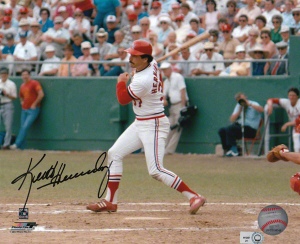 After several failed attempts at finding a first baseman, the Cardinals struck gold with Keith Hernandez. Was there a better defensive first baseman in the game ? A National League Most Valuable Player Award in 1979 and 11 Gold Gloves (6 with the Cardinals and 5 more with the Mets) suggest that he might have been. Nobody started a prettier 3-6-3 double play than Keith Hernandez. He charged the ball hard, made a crisp throw from inside the base line, well away from the runner, and scampered back to first base in time to receive the return throw. His presence on the field was much larger than his actual 6ft frame as he was the field commander, almost willing ground balls to be hit right to his teammates.
After several failed attempts at finding a first baseman, the Cardinals struck gold with Keith Hernandez. Was there a better defensive first baseman in the game ? A National League Most Valuable Player Award in 1979 and 11 Gold Gloves (6 with the Cardinals and 5 more with the Mets) suggest that he might have been. Nobody started a prettier 3-6-3 double play than Keith Hernandez. He charged the ball hard, made a crisp throw from inside the base line, well away from the runner, and scampered back to first base in time to receive the return throw. His presence on the field was much larger than his actual 6ft frame as he was the field commander, almost willing ground balls to be hit right to his teammates.
But Hernandez was not a one trick pony. He was the perfect bat to go with Whitey Herzog’s running style of offense. While he could hit with power, Hernandez’s greatest asset was some of the best gap-to-gap hitting we’ve ever seen in St. Louis. When you have runners like Garry Templeton, Lonnie Smith and Willie McGee on base, those shots into the gaps produced a frightening number of runs.
George Hendrick and David Green (1984) about 1 WAR apiece
An “in the dead of night” deal in 1983, sending Keith Hernandez to the New York Mets for pitcher Neil Allen signaled that something was very wrong in the Cardinals clubhouse. It would take another season for all of it to settle down so that White Herzog’s rabbits could return to the World Series. In this transition, David Green and George Hendrick platooned as first baseman. Both were converted outfielders, so the move to first base meant that neither were playing in a comfortable position. And their play backed that up. Hendrick had a cannon of an arm, but never got to show it off from first base. Green could run like the wind, but that athletic ability was rarely seen on the right side of the infield.
Hendrick was just starting his late career decline, and before the start of the next season, he would have a new home. That trade would would turn out to be one the best in Cardinals history as it brought left handed pitcher John Tudor to the gateway city.
For his part, Green never developed as Herzog had hoped. An injury in 1982 opened the door for a youngster named Willie McGee, and Green found himself on the outside looking in. With Andy van Slyke and Vince Coleman tearing it up in the minor leagues, his days with the Cardinals were numbered.
Jack Clark (1985-1987) 11.4 WAR (12.5 offensive, -1.1 defensive)
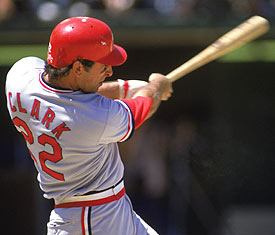 Another converted outfielder with a cannon for an arm. Like George Hendrick before him, he didn’t get much of a chance to see it put to use. His defense was much maligned in the day, but in retrospect that might have been more a function of the quality of the players surrounding him than his actual performance. After all, when Ozzie Smith is the shortstop and Tommy Herr the other middle infielder, you are going to have to play like Keith Hernandez to even get noticed.
Another converted outfielder with a cannon for an arm. Like George Hendrick before him, he didn’t get much of a chance to see it put to use. His defense was much maligned in the day, but in retrospect that might have been more a function of the quality of the players surrounding him than his actual performance. After all, when Ozzie Smith is the shortstop and Tommy Herr the other middle infielder, you are going to have to play like Keith Hernandez to even get noticed.
But that bat. Just as with Orlando Cepeda, injuries had caused the Giants to give up on him and the Cardinals were able to get the slugger for a modest price. Two of Clark’s seasons in St. Louis would be played relatively injury free, and the result were two trips to the World Series (1985, 1987). When they pitched to Clark, the slugger made things happen. Even in 1987, when pitchers didn’t even try to hide the fact that they were working around The Ripper, he still found ways to make the other teams pay dearly for any baseballs left close to the plate. He would be the first man since Richie Allen to hit 30 home runs for the Cardinals, and the last until Ron Gant accomplished the feat in 1996, after some renovations that transformed Busch Stadium into a more home run friendly park.
Curiously, the Cardinals did not resign Clark following the 1987 season and he eventually signed with the New York Yankees. Apparently the front office knew what they were doing as Clark never came close to the offensive production he’d shown in St. Louis in 1985 and 1987.
Bob Horner (1988) 0.2 WAR (0.5 offensive, -0.3 defensive)
 When Bob Horner and Dale Murphy broke in with the Braves in 1978, Atlanta thought they had captured lightning in a bottle. They hoped that they could build a perennial contender with Horner and Murphy at the core. Unfortunately it didn’t quite work out that way, although there were a lot of high points before injuries caught up with one of them. Breaking his wrist in 1983 and again in 1984 sapped most of the power Horner had shown early in his career. More than that, the ability to play a full season in the major leagues was just beyond his reach. After failing to find a suitor for the 1987 season, Horner played baseball in Japan for one season before returning to the Cardinals in 1988, taking over for Jack Clark. That didn’t last long as Horner would suffer a severe shoulder injury, ending his career.
When Bob Horner and Dale Murphy broke in with the Braves in 1978, Atlanta thought they had captured lightning in a bottle. They hoped that they could build a perennial contender with Horner and Murphy at the core. Unfortunately it didn’t quite work out that way, although there were a lot of high points before injuries caught up with one of them. Breaking his wrist in 1983 and again in 1984 sapped most of the power Horner had shown early in his career. More than that, the ability to play a full season in the major leagues was just beyond his reach. After failing to find a suitor for the 1987 season, Horner played baseball in Japan for one season before returning to the Cardinals in 1988, taking over for Jack Clark. That didn’t last long as Horner would suffer a severe shoulder injury, ending his career.
But all is not lost. This failure, through no fault of Horner’s, did open the door for a future fan favorite. With the Cardinals in free fall at the non-waiver trade deadline, a deal was worked between St. Louis and Los Angeles. The Cardinals would send fan favorite John Tudor to the City of Angles and in return we would receive Pedro Guerrero.
Pedro Guerrero (1989-1991) 2.9 WAR (6.7 offensive, -3,8 defensive)
 Big Pete was well into his late career decline when he made the trip across the continental divide to finish out his career in St. Louis. We didn’t see him at his best, for he was a beast of a hitter in his youth. When Guerrero was healthy, a .320 batting average and a slugging percentage in the mid to upper .500s could be counted on out of the slugger. If you missed him playing in Los Angeles, know that he also possessed some exceptional speed and twice stole 20 or more bases. That all came to an end when he ruptured a tendon in spring training in 1986. It cost him nearly the entire season, but he roared back in 1987 with some of the best offensive production in his career.
Big Pete was well into his late career decline when he made the trip across the continental divide to finish out his career in St. Louis. We didn’t see him at his best, for he was a beast of a hitter in his youth. When Guerrero was healthy, a .320 batting average and a slugging percentage in the mid to upper .500s could be counted on out of the slugger. If you missed him playing in Los Angeles, know that he also possessed some exceptional speed and twice stole 20 or more bases. That all came to an end when he ruptured a tendon in spring training in 1986. It cost him nearly the entire season, but he roared back in 1987 with some of the best offensive production in his career.
We didn’t know what to make of Pete when he came to St. Louis. He always seemed to have some of that George Hendrick or Juan Encarnacion lack of hustle, but we soon found out that the big man played the game very hard and he gave us three outstanding seasons at the end of his career. If not for an injury, we might have enjoyed him a bit longer.
Andres Gallaraga (1992) -0.4 WAR (-0.3 offensive, -0.1 defensive)
 The Big Cat played first base as his nickname suggests. He was a big man with soft hands and moved with the grace of Bill White. Oh, he was slick. And he’d won a pair of Golden Gloves with the Montreal Expos in 1989 and 1990. A hamstring injury suffered in 1991 led to a poor year for both Galarraga and the Expos. He became a Cardinal prior to the 1992 season. He got off to a good start, until his was hit by a pitch and suffered a broken wrist. As it so often happens, injuries to the hand area take a long time to heal, and he basically lost the ’92 season in St. Louis.
The Big Cat played first base as his nickname suggests. He was a big man with soft hands and moved with the grace of Bill White. Oh, he was slick. And he’d won a pair of Golden Gloves with the Montreal Expos in 1989 and 1990. A hamstring injury suffered in 1991 led to a poor year for both Galarraga and the Expos. He became a Cardinal prior to the 1992 season. He got off to a good start, until his was hit by a pitch and suffered a broken wrist. As it so often happens, injuries to the hand area take a long time to heal, and he basically lost the ’92 season in St. Louis.
But Cardinals pitching coach Don Baylor was impressed with the big man, and when he became the skipper of the Colorado Rockies, he swiped Galarraga at his first chance. And did he ever respond. How about hitting .370 in the thin air in Denver ? Injuries would slow him down there too, but he would also put together 5 consecutive seasons of 100 RBIs or more, the tops being 150 in 1996. Big Cat indeed.
We saw just a glimpse of what Galarraga was capable of in that short season. It would have been nice if the Cardinals front office had been just a bit more patient.
Gregg Jefferies (1993-1994) 6.9 WAR (7.3 offensive, -0.4 defensive)
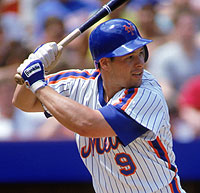 Jefferies came to the Cardinals by way of the Kansas City Royals, but we were more than familiar with him from his days with the New York Mets. It was hard to believe, but he was only 25 years old when he came to the Redbirds, but was starting his sixth full season in the big leagues. He’d never shown much power and didn’t hit for much of an average, so we were a little bit nonplussed when the Cardinals acquired him. Add to that a return to the little man at first base and we were all starting to wonder about the sanity of the front office.
Jefferies came to the Cardinals by way of the Kansas City Royals, but we were more than familiar with him from his days with the New York Mets. It was hard to believe, but he was only 25 years old when he came to the Redbirds, but was starting his sixth full season in the big leagues. He’d never shown much power and didn’t hit for much of an average, so we were a little bit nonplussed when the Cardinals acquired him. Add to that a return to the little man at first base and we were all starting to wonder about the sanity of the front office.
Any concerns about Jefferies playing hard were quickly put to rest. He turned in the two best years of his career in St. Louis, hitting .342 in 1993 and following that up with a nifty .325 average in the strike shortened 1994 season. The Cardinals chose not to offer him a contract following the 1994 season and he moved on to Philadelphia. Injuries and inconsistent play would bring about a premature end to his career.
We never saw it coming, but learned to appreciate the little man for those two seasons in the gateway city.
John Mabry (1995-1996) -0.3 WAR (-0.4 offensive, 0.1 defensive)
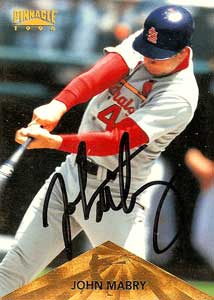 When the big man broke in with the Cardinals in 1995, he looked to be the second coming of Todd Zeile, but with a lot more plate discipline. Perhaps that is a bit more prophetic than I had intended, because after a quick start to his career, Mabry began to struggle at the plate. His average dropped from a steady .300 all the way to .249 before being released following the 1998 season. But Mabry was a good baseball man and continued to keep his career alive, making his way across most of the major leagues before coming back to St. Louis for a swansong season in 2004, reclaiming some of that early glory. Mabry was a big part of helping the Cardinals make it to the World Series.
When the big man broke in with the Cardinals in 1995, he looked to be the second coming of Todd Zeile, but with a lot more plate discipline. Perhaps that is a bit more prophetic than I had intended, because after a quick start to his career, Mabry began to struggle at the plate. His average dropped from a steady .300 all the way to .249 before being released following the 1998 season. But Mabry was a good baseball man and continued to keep his career alive, making his way across most of the major leagues before coming back to St. Louis for a swansong season in 2004, reclaiming some of that early glory. Mabry was a big part of helping the Cardinals make it to the World Series.
He turned out to be the perfect Tony La Russa scrappy utility player, playing nearly every position except catcher. The hardest thing for Cardinals fans was watching him end his career up Interstate 55, playing for the rival Cubs.
Dmitri Young (1997) 0.3 WAR (-0.3 offensive, 0.6 defensive)
 All the while John Mabry was holding down first base, we kept hearing the name Dmitri (Da Meat Hook) Young and how he was tearing it up in the minor leagues. He was going to be a masher at the plate and it was just a matter of time before National League pitchers retired rather than facing him.
All the while John Mabry was holding down first base, we kept hearing the name Dmitri (Da Meat Hook) Young and how he was tearing it up in the minor leagues. He was going to be a masher at the plate and it was just a matter of time before National League pitchers retired rather than facing him.
In just one full season in St. Louis, he failed to live up to the hype. Needing some help in the bullpen, the Cardinals traded Young to the Cincinnati Reds for Jeff Brantley. Young would have several good seasons in Cincinnati, but still didn’t live up to the hype we had been given during his early development. After a couple of good years in Detroit, Young would finish out his career with the Washington Nationals.
Mark McGwire (1998-2001) 22.5 WAR (26.3 offensive, -3.8 defensive)
 Tabling any discussions about the steroid era, Mark McGwire was a genuine basher. One of the best. From record setting rookie season when the red headed one would bash 49 home runs to a pair of seasons in St. Louis when he would hit over 60 homes, the man could bash with the best of them. A closer look at his career will reveal a player that worked very hard at his craft, and a rising batting average later in his career was the result. He would hit over .300 once, and just missed that one time in St. Louis. Injuries seemed to be a part of nearly every season for Big Mac, and towards the end of his playing days, it was almost painful to watch him take a swing.
Tabling any discussions about the steroid era, Mark McGwire was a genuine basher. One of the best. From record setting rookie season when the red headed one would bash 49 home runs to a pair of seasons in St. Louis when he would hit over 60 homes, the man could bash with the best of them. A closer look at his career will reveal a player that worked very hard at his craft, and a rising batting average later in his career was the result. He would hit over .300 once, and just missed that one time in St. Louis. Injuries seemed to be a part of nearly every season for Big Mac, and towards the end of his playing days, it was almost painful to watch him take a swing.
Big Mac will never go down in history has being one of the best defensive men to play the position, but he was sure a lot of fun to watch. Especially at a time when baseball needed a couple of heroes to erase the memories of a strike in 1994.
Tino Martinez (2002-2003) 3 WAR (2 offensive, 1 defensive)
 After the retirement of Mark McGwire and with no legitimate first baseman prospect in the minor league system, Tino Martinez seemed to be the perfect choice to take over first base when the Cardinals signed him following the 2001 season. After becoming a star in Seattle, Martinez had been a big name on one of the biggest stages for baseball, Yankee Stadium. When the Yankees opted not to sign him, the Cardinals moved quickly to secure the slugger.
After the retirement of Mark McGwire and with no legitimate first baseman prospect in the minor league system, Tino Martinez seemed to be the perfect choice to take over first base when the Cardinals signed him following the 2001 season. After becoming a star in Seattle, Martinez had been a big name on one of the biggest stages for baseball, Yankee Stadium. When the Yankees opted not to sign him, the Cardinals moved quickly to secure the slugger.
Disappointing doesn’t begin to describe the two long years he was in St. Louis. It seemed like everything he tried to do made things worse. He would only manage 69 and 75 RBIs and his batting average that once floated near .300 was heading towards .250 in a hurry. After the 2003 season, the Cardinals traded him to Tampa for a player to be named later, and they really didn’t want the player.
Martinez was such a professional, those two years had to be at least as hard on him as they were to the Cardinals fans.
Albert Pujols (2004-2010) 60 WAR (51 offensive, 9 defensive)
 And that brings us to Albert Pujols. Do I really need to say much about “El Hombre” ? I didn’t think so.
And that brings us to Albert Pujols. Do I really need to say much about “El Hombre” ? I didn’t think so.
The purpose of this article, as long as it has become, is to make exactly 2 points.
1. In the last 50 years, every Cardinals championship team has a common characteristic. They all had an MVP caliber offensive producer playing first base. In 1964 it was Bill White. In 1967 and 1968, it was Orland Cepeda. Keith Hernandez was the offensive force for Whitey Herzog’s only championship team in St. Louis in 1982. Two trips to the World Series, coming just a few outs from winning it all in 1985 and 1987 had Jack “The Ripper” Clark tearing things up. And 2004 and 2006 had Albert Pujols leading the offense.
But it’s even more than that, every time the Cardinals had an offensive leader at first base, they eventually made it to the World Series.
2. When you think of the great glove men that manned the right side of the infield, you think of Bill White and Keith Hernandez. According to the dWAR statistic, which claims to measure such things, Albert Pujols is every bit as good as those two defensive specialists, and perhaps just a bit better.
A slightly subtle sub-theme started developing as I typed out each of these paragraphs. A single season of Albert Pujols, both on the offensive and defensive side of the game, is more productive than many careers of players who played the position before him.
Without nullifying my cease-and-desist notice from a few days ago, I really do suggest that Bill DeWitt and the front office pay the man what he is worth. There hasn’t been anything like him in St. Louis for a very long time, and we really don’t know if we’ll see another any time soon.








